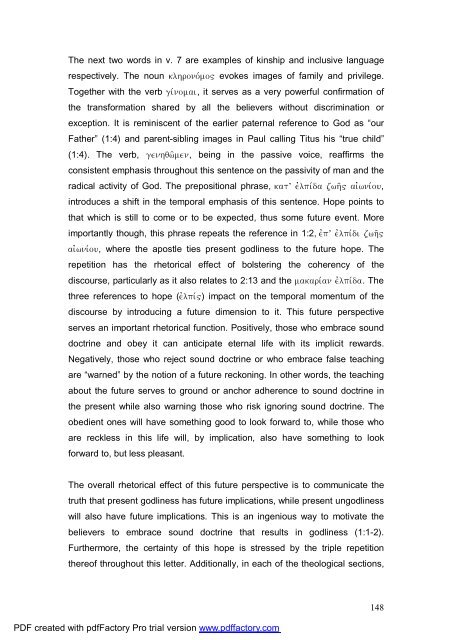A Text centred rhetorical analysis of Paul's Letter to Titus
A Text centred rhetorical analysis of Paul's Letter to Titus
A Text centred rhetorical analysis of Paul's Letter to Titus
You also want an ePaper? Increase the reach of your titles
YUMPU automatically turns print PDFs into web optimized ePapers that Google loves.
The next two words in v. 7 are examples <strong>of</strong> kinship and inclusive language<br />
respectively. The noun klhronovmo~ evokes images <strong>of</strong> family and privilege.<br />
Together with the verb givnomai, it serves as a very powerful confirmation <strong>of</strong><br />
the transformation shared by all the believers without discrimination or<br />
exception. It is reminiscent <strong>of</strong> the earlier paternal reference <strong>to</strong> God as “our<br />
Father” (1:4) and parent-sibling images in Paul calling <strong>Titus</strong> his “true child”<br />
(1:4). The verb, genhqw`men, being in the passive voice, reaffirms the<br />
consistent emphasis throughout this sentence on the passivity <strong>of</strong> man and the<br />
radical activity <strong>of</strong> God. The prepositional phrase, katÆ ejlpivda zwh`" aijwnivou,<br />
introduces a shift in the temporal emphasis <strong>of</strong> this sentence. Hope points <strong>to</strong><br />
that which is still <strong>to</strong> come or <strong>to</strong> be expected, thus some future event. More<br />
importantly though, this phrase repeats the reference in 1:2, ejpÆ ejlpivdi zwh`"<br />
aijwnivou, where the apostle ties present godliness <strong>to</strong> the future hope. The<br />
repetition has the <strong>rhe<strong>to</strong>rical</strong> effect <strong>of</strong> bolstering the coherency <strong>of</strong> the<br />
discourse, particularly as it also relates <strong>to</strong> 2:13 and the makarivan ejlpivda. The<br />
three references <strong>to</strong> hope (ejlpiv~) impact on the temporal momentum <strong>of</strong> the<br />
discourse by introducing a future dimension <strong>to</strong> it. This future perspective<br />
serves an important <strong>rhe<strong>to</strong>rical</strong> function. Positively, those who embrace sound<br />
doctrine and obey it can anticipate eternal life with its implicit rewards.<br />
Negatively, those who reject sound doctrine or who embrace false teaching<br />
are “warned” by the notion <strong>of</strong> a future reckoning. In other words, the teaching<br />
about the future serves <strong>to</strong> ground or anchor adherence <strong>to</strong> sound doctrine in<br />
the present while also warning those who risk ignoring sound doctrine. The<br />
obedient ones will have something good <strong>to</strong> look forward <strong>to</strong>, while those who<br />
are reckless in this life will, by implication, also have something <strong>to</strong> look<br />
forward <strong>to</strong>, but less pleasant.<br />
The overall <strong>rhe<strong>to</strong>rical</strong> effect <strong>of</strong> this future perspective is <strong>to</strong> communicate the<br />
truth that present godliness has future implications, while present ungodliness<br />
will also have future implications. This is an ingenious way <strong>to</strong> motivate the<br />
believers <strong>to</strong> embrace sound doctrine that results in godliness (1:1-2).<br />
Furthermore, the certainty <strong>of</strong> this hope is stressed by the triple repetition<br />
there<strong>of</strong> throughout this letter. Additionally, in each <strong>of</strong> the theological sections,<br />
PDF created with pdfFac<strong>to</strong>ry Pro trial version www.pdffac<strong>to</strong>ry.com<br />
148

















